Tim Warnes's Blog: My Life in Books, page 19
September 27, 2019
Owl Babies

Owl Babies / Ceramic and upcycled wood sculpture by Tim Warnes. Image © by Tim Warnes 2018
[Animals] have always been sequestered for storytelling and metaphor, perhaps precisely because they can’t talk back. So we imaginatively put words in their beaks, snouts and jaws, and have them explain the world to our smallest ones in a (mostly) unthreatening way. But isn’t it strange that such an emblem of wildness as the untameable owl can have come to seem so domesticated?
— Owl Sense by Miriam Darlington
04.55 AM. Outside my bedroom window, an owl is calling.
Over the babble of the stream, this call of the wild instantly pulls me from the arms of sleep. I lie there in the dark with bated breath, waiting - and wanting - to hear it again.
Hu. Huhuhuhooo.
I am taken back to childhood - there's the excitement, the sense of adventure - and just a little touch of danger thrown in.
Yes - owls' hoots still thrill me.
This feeling partly stems from a childhood fear of the dark.
The snap of a twig; the pained yelping of a fox; thoughts of disorientation and abandonment.
Being left alone with whatever else the dark is hiding.
I have always had a fascination with owls. I remember we were driving home in the dark once from visiting my grandparents. I was pretty young - five or six. Suddenly a barn owl swooped down in front of the car and flew ahead of us. A phantom, glowing bright white in the beam of the headlights, leading us home. (An effect enhanced by the fact that it happened to be Halloween.)
What is it about owls that so endear them to us? What quality is it that makes them so mesmerising? Some have those deep, black, liquid eyes that look like they contain the secrets of the universe. Other species, with piercing orange or yellow eyes, feel like they can look inside and read your every thought.
This week, prompted by the hooting owls of the owls outside my bedroom window, I'd like to share some thoughts on a modern classic, the picture book Owl Babies by Martin Waddell, illustrated by Patrick Benson (Walker Books 1992).

Owl Babies © by Martin Waddell and Patrick Benson (Walker Books 1992)
I pull our dog-eared copy from my shelf. There are those familiar faces - Sarah, Percy and little Bill. The Owl Babies.
Described by the Guardian as 'the perfect picture book', Owl Babies has been around now for over 25 years. Rereading it brings back a flood of memories of snuggling up with my boys at bedtime. Martin Waddell's gentle, soporific words, and the magical illustrations of the dark woodland, conjured up by Patrick Benson, made it a favourite of ours.
The realistically portrayed owls live in a believable night time world of silhouettes and darkness, which Benson deliberately chose to give a cinematic feel to. We begin high in the canopy of an old ivy-clad ash tree; then down into its hollow trunk, where we are introduced to Owl Mother and her three baby owls: Sarah, Percy, and Bill.
The hole had twigs and leaves and owl feathers in it.
It was their house.
Waddell got the idea for the story when he was out shopping for dog food. '[There was a] 'wee kid by the checkout. It had lost its mammy. And it was very, very scared.' Despite a flotilla of ladies trying to calm it down with sweets, the kid just kept repeating the phrase - I want my mummy - over and over again.
'And I went home and wrote the story. ... I've had picture books that have taken me 18 years to write. This thing took about three hours.'
- Author Martin Waddell Discusses "Owl Babies
'Owl Babies tackles the subject of temporary separation - a situation which all children are likely to experience, be it Mum going to work or first day at Nursery' - while tapping into more deep-seated fears of being abandoned; of getting lost or separated; of the dark.
One night [the baby owls] woke up and their Owl Mother was GONE.
"Where's Mummy?" asked Sarah.
"Oh my goodness!" said Percy.
"I want my mummy!" said Bill.
Patrick Benson reveals the secret to capturing the feel of a night time woodland in his beautiful illustrations:
I was brought up on a farm and used to spend hours roaming around the woods and fields, climbing trees and discovering the wonders of nature. I also like fishing, and particularly fishing at night, so again I know what the countryside can look and feel like after dark. All of this was incredibly helpful in making the pictures for this book.
- Patrick Benson on Creating the Artwork for Owl Babies
It's heartwarming to see how the baby owls look after each other. They come out of their house holding hands, and they sit, and they wait in that dark woodland, wondering about their mother. The owlets assess their predicament, trying to reassure each other - "She'll be back," said Sarah. "Back soon," said Percy - and all the while little Bill repeats, "I want my mummy!" Yet behind their brave words, the tension and uncertainty are palpable. It captures children's imaginations without filling them with fear, because, as illustrator Benson says, 'the resolution is so complete and comforting.'

Detail from Owl Babies © by Martin Waddell and Patrick Benson (Walker Books 1992)
Benson's use of silhouettes and bold patches of solid black is relatively unusual for a picture book because it doesn't really lend itself to creating a comforting atmosphere. But somehow he pulls it off, depicting the night time wood so well. Details of ferns and brambles and that great, old ash tree, patterned by little patches of moonlight accompany text that reads, 'It was dark in the wood and they had to be brave, for things moved all around them.'
And there they are, the three baby owls, dwarfed by night.
The most satisfying page turn comes when the baby owls - shown in close-up - close their owl eyes and wish their Owl Mother would come.
‘And she came.’

Owl Babies © by Martin Waddell and Patrick Benson (Walker Books 1992)
The big, fat image of mother owl returning home is just so solid and welcome. And the delight of her owl babies is really touching as we see them flap and dance and bounce up and down on their branch.

Owl Babies © by Martin Waddell and Patrick Benson (Walker Books 1992)
Undoubtedly, Owl Babies was subconsciously influencing my ideas as I jotted down the story seed for The Owl Tree.
Inspired by a real-life tree and real-life owls, it reads a bit like a prequel for slightly older readers:
I'm not surprised that Owl Babies has endured.A late winter North Westerly brings with it an unexpected snowfall. The whirling, twirling flakes tease and chase each other around the Owl Tree. Deep inside, Mother Owls sits alone on her three snowy white eggs, round and bright in the twiggy gloom. Hidden from the wind's icy breath and the snow's biting touch.
Story Seed: The Owl Tree by Tim Warnes
Its endearing characters, relatable themes, satisfying ending and just the right amount of uncertainty makes Owl Babies a great bedtime read. And with that little bit of danger thrown in, you might get even more of a snuggle! It's a win-win.
Good to readOther snuggly owl books
Love Enough for Two by Jane Chapman (Little Tiger Press 2017)
I'm Not Sleepy by Jane Chapman (Little Tiger Press 2012)
A Bit Lost by Chris Haughton (Walker Books 2011)
The Owl and the Pussycat by Edward Lear, ill. by Louise Voce (Walker Books 2002)
SourcesOwl Sense by Miriam Darlington (Guardian Faber Publishing 2018)Owl Babies by Martin Waddell, ill. by Patrick Benson (Walker Books 1992) Author Martin Waddell Discusses "Owl Babies" Owl Babies on Booktrust Patrick Benson on Creating the Artwork for Owl Babies - Foyles blogThe Owl Tree by Tim Warnes (unpublished)September 19, 2019
Pretty in pink

From Only You Can Be You! by Nathan and Sally Clarkson (Tommy Nelson 2019) Illustration © 2019 by Tim Warnes
[Biological differences] have a tiny effect on gender roles compared to conditioning. We love to think that boys are ‘naturally’ more physical, less well behaved, more stoic. I think we like the idea that gender is in our genes because it is convenient, it lets us off the hook. It lets parents off the hook for the gendered ways we treat our children ... It lets society off the hook for how we encourage gender stereotypes, and it lets us all off the hook for acting them out every minute of every day.
— Grayson Perry, The Descent of Man
It fascinates (and sometimes shocks) me how we make associations and judgements about things based on culture.
Take the colour pink, for instance.
As a young boy, I wore (and loved) a salmon pink two-piece denim outfit - jacket and trousers. Fair play to my parents. As a teen, I was inspired by Miami Vice, modelling myself after Don Johnson in a pink jacket (with rolled the sleeves up, of course).
Pink shirts; pink tee shirts. Nope. Pink has never been a problem for me. But the pervading culture tells me that pink is for girls.
The poor guy was born in the wrong century! Because a little over a hundred years before, his friends would have thought differently. Back then, pink was viewed as a masculine colour (‘a kind of boyish version of the masculine colour red’ of military uniforms). Blue (in Catholic countries at least) was regarded as a feminine colour because of the association with the Virgin Mary's traditional attire. In June 1918, the Ladies’ Home Journal, an American publication, stated that ‘pink, being a more decided and stronger colour, is more suitable for the boy, while blue, which is more delicate and dainty, is prettier for the girl.’
But that was before the 1950s, when ‘there was a huge advertising campaign by several advertising agencies pushing pink as an exclusively feminine colour.’
Ahh, the power of persuasion.
Fast forward several decades, and while some parents at the toddler group were debating whether their boys should be encouraged - allowed even - to play with dolls or anything remotely pink, my boys grew up being allowed to express themselves with few limits.
Noah adopted the persona of Tina Turner (complete with pink glitter wig and tutu) and would make a big show of entering the room - “Presenting! Tina. Turner!” (at which point onlookers were expected to pay cheer and marvel at Tina’s guitar playing). We have a photo of him somewhere, grubbing around outside with Scoop the Digger wearing that outfit. (He was the inspiration behind the illustration used in last week’s post of the kid wearing a pink tutu with an army camo top.)
Earlier this year I visited my godson. He was playing with a doll in a pink pushchair. It reminded me of our other son, Levi. When he was about two, he chose a doll (Baby Dave) - and a pushchair to go with him. It started out as rinky-dink pink, but by then, Noah was about eight years old and conditioned by society that pink was for girls. So Jane pimped Baby Dave’s ride and made an army camouflage sling for it. All that remained of its former glory were the handles, wheel hubs and frame clips.
Michael Reichert, author of How To Raise a Boy, sums up my feelings in this quote:
We wanted a boy who had his own mind, who was picking up that who he was mattered to us, that we were going to get to know him rather than merely requiring him to fit into what we expected a boy to be.
- Raising Boys With a Broader Definition of Masculinity (The Atlantic)
Here’s how it affects children’s books. I’ve heard publishers say that boys won’t read a book with a pink cover. Really? Not in my experience. One of the boys’ favourite picture books was one of the pinkest books imaginable - Dear Tooth Fairy by Alan Durant (Walker Books 2004), illustrated in shades of pink throughout by our friend, the late Vanessa Cabban. Other pink covered favourites include Big Rabbit’s Bad Mood by Ramona Badescu and Delphine Durand (Chronicle Books 2007) and Lavender by Posy Simmonds (Red Fox 2004).
I think it’s more likely that boys are dissuaded from pink stuff by cues they have picked up along the way, and well meaning adults (which harks back to last week’s opening quote by Grayson Perry). I imagine - but this is pure speculation - that the same is likely to be true of the current rash of books about unicorns and mermaid.
Here’s a rare example of a boy wearing pink in a picture book - Ezra Jack Keat’s character, Peter, from 1964’s Whistle For Willie (Viking).

From Whistle For Willie (Viking 1964) © 1964 by Ezra Jack Keats
I am against labelling books by age or gender - a practice that I’m glad to note (here in the UK, at least) appears to be dying out.
This is largely in part to the Let Books Be Books campaign, which has pushed for an end to gendered book titles in the UK. A recent movement, it has persuaded eleven children’s publishers to remove the words ‘for boys’ and ‘for girls’ from book covers since 2014.
We should be breaking down gender stereotypes. But by labelling books, we are, by default, enforcing those stereotypes, sending the message, This book is not for you. You’re the wrong gender. You should read this instead. A short-sighted marketing ploy on the part of publishers which tries to eliminate half a book’s potential readers. That’s crazy!
How can we tell girls that they can grow up to be whatever they want - engineers, astronauts, explorers etc., yet at the same time say, Here, this book is just for girls ?
How can we tell boys, Come out of your man cave? It’s okay to cry - then turn around and say, Sorry. That book isn’t for you. You’d better put it down. It's only for girls ?
Let books be books. Let kids be kids.[Such] books send out very limiting messages to children about what kinds of things are appropriate for girls or for boys. Blue covers, with themes of action and adventure, robots, space, trucks and pirates contrast with a riot of pink sparkles, fairies, princesses, flowers and butterflies. But real children’s interests are a lot more diverse, and more interesting, than that…
Children are listening, and take seriously the messages they receive from books, from toys, from marketing and the adults around them. Do we really want them to believe that certain things are off-limits for them because of their gender? They’re not ‘getting it wrong’ if a girl likes robots, or if a boy wants to doodle flowers. These artificial boundaries turn children away from their true preferences, and provide a fertile ground for bullying.
- Let Books Be Books
Yes, introduce them to books that you rate highly. (Unsure where to start? Take a look at my Good to Read recommendations.) But don’t force a story time. Follow their lead. If your daughter wants nothing but pink princess and unicorn books, that’s cool. But don’t be too concerned if your son does as well. Likewise, if he wants to read about trains and diggers and warrior knights, then go with it. Let them be inspired to become who they want to be. And using books - all sorts - you can help them work it out.
SourcesTHE DESCENT OF MAN BY GRAYSON PERRY (ALLEN LANE 2016)Pink used to be a boy's colour and blue a girl's – here's why it all changed - Business Insider (Oct. 7, 2017)Raising Boys With a Broader Definition of Masculinity by Julie Beck (The Atlantic, April 15, 2019)Whistle For Willie by Ezra Jack Keat (Viking 1964)Let Books Be BooksSeptember 12, 2019
Drag Queen Story Hour

From Only You Can Be You! by Nathan and Sally Clarkson (Tommy Nelson 2019) Illustration © 2019 by Tim Warnes
When discussing manliness, the elephant in the room [is] not homophobia but perhaps a fear of appearing gay. This fear runs like an electric fence around the territory that is acceptably masculine. This is somewhat ironic, as the Department of Masculinity’s long-running propaganda campaign for Traditional Manhood may look a lot like a Village People-themed costume party.
— Grayson Perry, 'The Descent of Man'
I suppose one of the first, and most natural, ways kids explore gender is through dressing up and play.
Aged four or five, sat next to my mother at her dressing table, I’d watch, fascinated, as she applied her make-up. I liked trying out her lipstick, imitating the way she pursed her lips together to coat them evenly. It even smelt good. Once, my mother left me alone in the back of the car while she called in on a friend to collect something (well, it was the 1970’s!). I grabbed the opportunity to clamber through to the driver’s seat, peered intently into the rearview mirror, and smeared that lippy on!
Maybe my lipstick fascination was partly because I wanted to be a clown - the make-up being merely an extension of that. I certainly don’t remember Mum making a big deal of it. (She would also help me try on her jewellery.)
This is partly why the press coverage surrounding a recent phenomenon in the US - Drag Queen Story Hour - has been bothering me. But not necessarily for the reasons you might first suspect.
Aside from a penchant for Mum’s lippy, I grew up being entertained by pantomime dames, Dame Edna Everage (“Hello, Possums!”), and Cissie and Ada. As a young teen, I was a fan of Boy George and Culture Club. In recent years I have been educated and enlightened by the erudite Grayson Perry (transvestite artist /Reith Lecturer/ writer/presenter - and a married heterosexual).
But there are those who object vociferously.
Why? Are the queens being unsuitably coarse or using inappropriate language? If so, call them out on it. (This is storytime for kids, after all.)
Is the objection that the storytellers wear clothes and styles that our culture deems unsuitable for a man (too feminine; too flamboyant; too glittery; too pink)?
Hmmm…
Over the years, I have also enjoyed watching male actors play female characters - in films such as Some Like it Hot, Tootsie, Mrs Doubtfire, and Hairspray. In 2015 I was fortunate enough to see David Suchet tread the boards as Lady Bracknell in The Importance of Being Earnest. I have survived the pernicious effects of all - including the pantomime dames. How far removed are they from Drag Queen Story Hour? Is there some cultural snobbery at play? Is it not all just theatre?
Admittedly, I would be uncomfortable if Drag Queen Story Hour was used to directly promote or discuss LBGTQ+ issues when posing as storytime.
(I’m not saying those discussions shouldn’t be had with children - but carers shouldn’t be ambushed).
My guess is that many parents would welcome any questions that naturally arise as a good starting point for age-appropriate discussion. As the owner of the Paperback Exchange bookshop in Florida explains, ‘the purpose of [Drag Queen Story Hour] is to promote literacy, tolerance and self-expression.’
“The queens dress appropriately and modestly and, of course, we don’t talk about LGBTQ sex. Why would we?”
Bookstore Drag Queen Readings Win Fans, Draw Protests
Another such Story Hour - held at Virginia Beach Public Library - advertised itself as an event that ‘captures the imagination and play of childhood and gives kids glamorous, positive, and diverse role models.’
So if Drag Queen Story Hour does what it says on the tin - some stories, some singing of children’s songs (maybe a little craft thrown in) then great! We need to encourage kids to engage with books and literacy while opening their minds to the fact that not everyone on this planet looks (or feels) the same as them. I’ve performed in front of hundreds and hundreds of kids, and man - they can be a tough crowd! That’s why I think a dynamic, crowd-pleasing, attention-grabbing storyteller (used to performing and being heckled), would be eminently qualified! (The drag queens, incidentally, are often trained by children’s librarians.)
Instead of performing in seedy bars, drag queens are using their love of music, theatricality and elaborate costumes to help caregivers entertain little kids. “It’s a way,” said Jonathan Hamilt, a co-founder of the program, for the performers “to get out of the nightlife and into their communities, their neighbourhoods, their towns where they live and give back.”
Leave Drag Queen Story Hour Alone! By Michelle Goldberg
And you know what? - that makes me smile.
Whereas alarmist accounts of Drag Queen Story Hour like these just make me feel uneasy and sad:
“[W]e witnessed parents taking their children as young as two inside, to take part.”
- CBN reporter, Charlene Aaron, suggesting the library was unsafe and had become some kind of den of iniquity.
“We have a bunch of homosexuals that are molesting children. They are doing it with your help.”
- Trump supporter who showed up to a library with a gun because a drag queen was reading stories to children.
- One of many hateful comments left on the Facebook event page of ‘Drag Story Hour’ at the Children’s Book Cellar shop in Waterville, Maine.
The CBN report is particularly alarmist: ‘[O]utraged residents argue the programme will harm kids,’ reports Aaron. One (looking more fearful and confused than outraged) feels that her city isn’t keeping its citizens safe - especially the children:
…[T]hey’re going to get exposed to something that they’re really not sure about and be confused.
Ah. There’s the nub of the problem. Fear arising out of misunderstanding and confusion. It’s not just the kids who have their minds opened when we start being more inclusive and challenging misconceptions.
She was inspired to continue with her events (despite the inevitable protests) ‘after hearing an exchange between one of the readers and a young child in attendance’:
It was a little girl who said to one of the drag queens after a reading, ‘My brother likes to wear my mommy’s dresses,’ to which the queen responded, ‘and that is perfectly okay.’ It was then that I knew we were doing something good for the community.
My review of Julian is a Mermaid by Jennifer Love (Candlewick Press 2018) - a story ‘about acceptance, and the power of those closest to children either to shame them into harmful conformity or to welcome and celebrate their self-expression...'
- (Imogen Russell-Williams, The TLS)Ensure you don't miss the article!
Sign up for your weekly reminder
First Name
Last Name
Email Address
Sign Up
We respect your privacy.
Thank you!
SourcesOnly You Can Be You! What makes you different makes you great! by Nathan and Sally Clarkson, ill. by Tim Warnes (Tommy Nelson 2019)The Descent of Man by Grayson Perry (Allen Lane 2016) Bookstore Drag Queen Readings Win Fans, Draw Protests By Ed Nawotka (publishersweekly.com) Leave Drag Queen Story Hour Alone! By Michelle Goldberg (New York Times, June 7, 2019) Drag Queen Story Hours' Expose Pre-Schoolers to What Some Parents Call 'Gender Insanity (CBN News, Aug. 14 2018) Trump supporter 'shows up to library with gun' because drag queen was reading stories to children by Chris Baynes (the Independent, 1 Feb. 2019) Children’s bookstore in Maine receives backlash over ‘Drag Story Hour’ event By Arianna MacNeill (Boston.com May 14, 2019) Play dress-up until you find the right outfit by Imogen Russell Williams
September 6, 2019
A bit about birds

Detail from Only You Can Be You! by Nathan and Sally Clarkson (Tommy Nelson 2019) Illustration © 2019 by Tim Warnes
Sometimes I think that the point of birdwatching is not the actual seeing of the birds, but the cultivation of patience. Of course, each time we set out, there’s a certain amount of expectation we’ll see something, maybe even a species we’ve never seen before, and that it will fill us with light. But even if we don’t see anything remarkable - and sometimes that happens - we come home filled with light anyway.
— Lynn Thomson, 'Birding with Yeats: A Mother's Memoir'
Ever since I can remember, I have been a bird nerd. A nature nerd through and through - but it was the Avian family that really stole my heart.
I remember lounging on my parents’ bed, pouring over their copy of the Reader’s Digest Book of British Birds. With stunning illustrations by Raymond Harris Ching, it was a hefty tome for a four /five-year-old. The cover image - a gorgeous tawny owl that appeared to be squeezed into the space, leaving no room for a title - is ingrained in my memory. Even now, it stands out as a daring design.
British Birds filled me with awe and respect, and I treated it with due reverence as if it were the lectern’s Holy Bible. In the light and warmth of that quiet, south-facing bedroom, I dreamt of spotting all kinds of rarities. Meanwhile, house sparrows chirped outside, and wind-up wagtails made tiny sprints across the road.
The first bird guide of my own was a much-cherished copy of the Usborne Spotter’s Guide to Birds (chosen in place of an Easter egg, circa 1976). I loved that little yellow book. I have such a vivid memory of receiving it, immediately making a start on my list of birds seen (the first tick went to a pair of crooning collared doves in the neighbour’s pine).

Book of British Birds: illustration © 1972 by Raymond Harris Ching
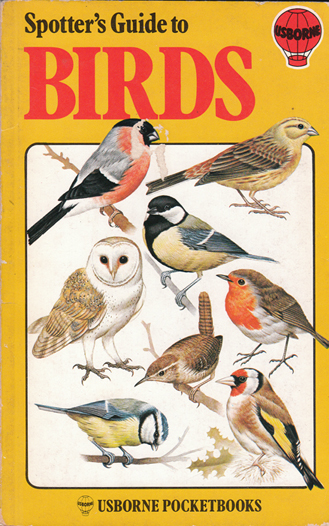
Illustration © 1981 by Trevor Boyer
But as the years went by, being a bird nerd filled me with shame.
Stupid, I know (now).
Back in the eighties, breakdancing, boomboxes, Bon Jovi and the Boss were cool. The Brat Pack were cool. Being a teenage birder was not.
It wasn’t until 1985 that naturalist Chris Packham ‘crept nervously and naively onto the set of the Really Wild Show with a blonde quiff and crepe-soled shoes.’ It’s reported he was told, “you’re passionate about wildlife and you look weird. You’re perfect.” I was already fifteen years old - so he arrived too late to sway my teenage peers (even so, I loved the Really Wild Show). I continue to admire him today.
By then I was volunteering with the RSPB; taking twilight walks to hear the churring of nightjars; making 5 am starts for dawn chorus walks; and pishing in the bushes.* It was like my secret identity. And when mates came around unexpectedly, I’d shove my pile of bird magazines under the bed as if they were porn.

Field sketch: Cormorant © by Tim Warnes
My favourite local birding haunt was some flooded gravel pits in Sandhurst, Berkshire. I’d cycle there with my binoculars and ‘scope slung across my back; dump my crappy racer in the hedge and squeeze between the barbed wire.
Over the years, I spent many happy hours spotting, noting and sketching some gorgeous birds: breeding little ringed plovers, goosanders, kingfishers, green and common sandpipers, grey wagtails, sedge warblers, water rails, great crested grebes - all duly submitted to the local bird group (whose logo I designed). I was there once, savouring a rare treat - a grumpy-looking little owl, hunched up in the crook of an oak tree. At the same time, two teenage girls approached on the bridleway that ran parallel to my path behind the hedge. They passed by on their horses, mocking and sniggering at the teenage birder. I felt such a loser and dared not turn around. Mainly because I didn’t want to face their ridicule; but maybe, more importantly, one of them (an old friend from primary school who I’d recently become reacquainted with) was a former crush. (I made her a Valentine’s card when I was about eight years old, which she promptly ripped into pieces in front of my classmates. Ouch. I said I related to Charlie Brown!)
But now I’m not ashamed to identify as a birder. I will perfectly happily walk along the road with my binoculars on display! No need to try and hide them anymore. Because what makes me different makes me great!
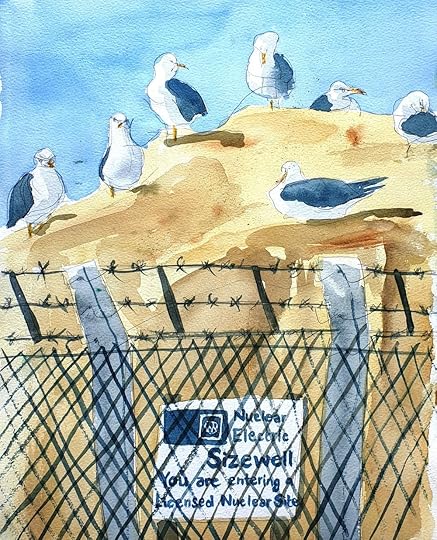
Field sketch: Lesser black-backed gulls, Sizewell Nuclear Power Station, Suffolk. Illustration © 1991 by Tim Warnes
My lifelong passion for birds led to my decision to add lots of them to the art for Only You Can Be You - What Makes You Different Makes You Great!
52 birds in all, each one an incidental detail. Illustrating them - mostly with collage - was a real joy. They definitely liven up the art with their colour and movement. And they got me thinking: One day, I’d really like to illustrate a book all about birds.
That would be awesome!
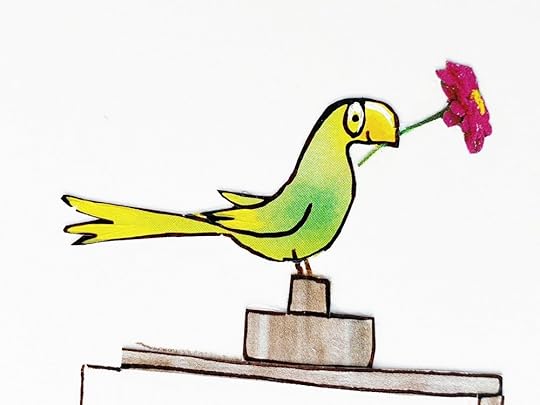
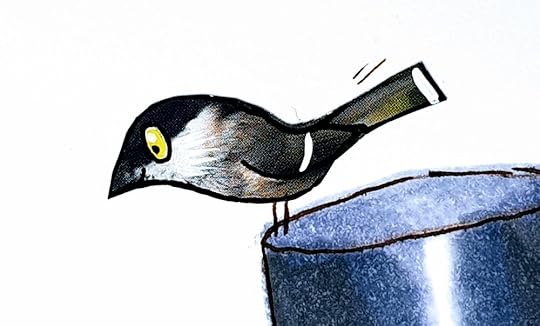

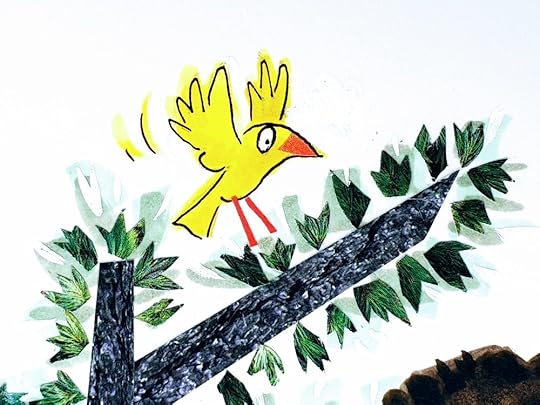

SourcesONLY YOU CAN BE YOU! WHAT MAKES YOU DIFFERENT MAKES YOU GREAT! BY NATHAN AND SALLY CLARKSON, ILL. BY TIM WARNES (TOMMY NELSON 2019)Birding with Yeats: A Mother's Memoir by Lynn Thomson (House of Anansi Press 2014)Book of British Birds, ill. by Raymond Harris Ching (Reader's Digest Association Limited 1972)Spotter’s Guide to Birds by Peter Holden, ill. by Trevor Boyer (Usborne 1981)The New Face of Springwatch by Chris Packham (BBC Wildlife Magazine, June 2009)Pishing by Melinda Mayntz (thespruce.com)
August 29, 2019
Using picture books to combat racism

From Only You Can Be You! by Nathan and Sally Clarkson (Tommy Nelson 2019). Illustration © 2019 by Tim Warnes
Our diversity is our strength and our unity is our power.
— Nancy Pelosi, speaker of the United States House of Representatives (@SpeakerPelosi)
I caught an interview the other afternoon with former England footballer, John Barnes.
I am not the least bit interested in football, but his response to recent racist attacks within football grabbed my attention. Why? Because I believe his points are pertinent to the ongoing discussion about diversity in the picture book market.
Barnes was responding to calls for professional footballers to boycott social media for six months to help combat racism. This followed racist tweets against Manchester United player, Paul Pogba - 'one of a growing number of black footballers receiving racists abuse on social media.'
I saw that tweet from that boy and if Pogba had scored that penalty ... that boy would not have tweeted that. But he still would have had that thought in his head … We have to tackle the cause of racism, not the symptom... Now, what makes that boy feel the way he does? Obviously what society has wrongly shown him about different groups of people and making people feel superior - that's what we have to tackle through education. You can pass as many laws as you want; you can come off Twitter. That's not gonna stop people being racially biassed. … We keep tackling symptoms, and if you don't tackle the cause, the symptoms keep coming back in different ways.
I don't think [racism in football is] getting worse. I thought it was always the same. It was exactly the same. And it's exactly the same in society. Football is a reflection of society. Now is racism in society getting better? No! So why should it be getting better in football? Why should football be different to society? And until we target it in society, it will exist in all forms of society - of which football is one. We cannot fight racism in football and make it better if it's not getting better in society. It's impossible. Because before we are racist football fans, we are racist members of society. … ... We have to tackle what we've learned in society and recondition ourselves - not pass laws.
- John Barnes interviewed on PM (BBC Radio 4, 20/08/2019)
'We have to tackle what we've learned in society and recondition ourselves' - the implication is huge for anyone who has the opportunity (and responsibility) of influencing the minds of children. Which is why the diversity debate in picture books is so crucial. Because conditioning starts as soon as the child is born, as the 2018 BBC series, Babies: Their Wonderful World demonstrated so clearly.
In episode 1, Professor Jessica Somerville Phd (University of Washington, USA) conducted 'a simple experiment to see if babies, like adults, have a preference for people who are like them or similar to them in some way, shape or form.' Physical differences are easier for babies to distinguish than something that can't be seen (for example, economic status, some disabilities, values). So the researchers based their experiment on the most apparent visual difference between us - our ethnicity. The study (a repeat of an earlier American one) was conducted on UK toddlers from a predominantly white neighbourhood.
The results surprised me - and challenged me in my role as an illustrator of picture books.

From Only You Can Be You! by Nathan and Sally Clarkson (Tommy Nelson 2019). Illustration © 2019 by Tim Warnes
Professor Somerville’s experiment consisted of two parts.
A baby watches as a white adult shares out toys between two adults. It is done in an obviously unfair manner - one participant receives lots of toys, the other just a few.
The scenario is then repeated, but with an Asian adult in charge. This time, the toys are divided equally between the two adult subjects.
The toddler can clearly see that in this instance, the White leader is unfair - but the Asian one plays fair.
Now it gets interesting.
‘Who do you want to play with?'
The toddler is given the choice of playing with the unfair or the fair leader. You'd think they would choose the fair (Asian) leader, right? And that is their initial instinct: they cautiously point and gesticulate towards the Asian; a few tentative steps towards them are taken. But at the last moment, each (white) child changes its mind, making a beeline to the Caucasian leader.
The white babies consistently chose to play with the distributor who was most like them visually - even though they could be seen to be unfair. Familiarity won out over fairness.
Professor Somerville concluded that the White children studied (who have no experience of Asian people) felt safer with someone who shared their racial makeup. In other words, those with a familiar-looking face.
[The results] suggest that already in the second year of life, infants are tuned in to thinking about who they want to interact with, through their evaluations of other people. Also, it suggests that a lot of those preferences have their roots quite early in development… Infants are quite sensitive to the social information they receive on a daily basis. [They're] encoding that information, they're remembering it, and ... using it to guide the kind of sophisticated decisions like, Who am I going to play with?
The experiment's conclusion supports the concern raised by John Barnes regarding the boy who made the racist tweet:
… when he has a job, and he has to interview two people - one's black, one's white - because of the way he thinks, we know who he's going to give the job to. That's what we have to try and change - people's perception.
Which is where creators of picture books come in.
October 2019 sees the release of a book that I'm really excited to have been part of - Only You Can Be You! What Makes You Different Makes You GREAT, written by Sally and Nathan Clarkson (Tommy Nelson 2019).It celebrates diversity - both through the Clarkson's text, and my art. Which has societal value, as Professor Somerville explained:
Infants are quite sensitive to the social information they receive on a daily basis. … using it to guide the kind of sophisticated decisions like, Who am I going to play with?
And later on in life, Who am I going to give a job to?
Clearly the more diverse a child’s upbringing, the less likely they will grow into adults with racist biases. Only You Can Be You! is full of different coloured kids. In small ways like this, I can strike a blow at racism. By sharing books like this with your kids, we are united and the blows are multiplied. As Nancy Pelosi tweeted:
Our diversity is our strength and our unity is our power.
I know it's a small drop in a vast ocean. But I hope Only You Can Be You! will contribute to a change in culture and recondition society. We have to start somewhere. Because at the end of the day, we shouldn't blame that kid's racist slurs on Twitter. He's just reflecting the society he's born into.

From Only You Can Be You! by Nathan and Sally Clarkson (Tommy Nelson 2019). Illustration © 2019 by Tim Warnes
GOOD TO READ
The New Small Person by Lauren Child (Puffin 2014)
So Much by Trish Cooke, illustrated by Helen Oxenbury (Walker Books 1994)
Leon and Bob by Simon James (Walker Books 2008)
The Snowy Day by Ezra Jack Keats (Viking 1962)
Julian is a Mermaid by Jessica Love (Walker Books 2018)
Yumi by Annelore Parot (Chronicle Books 2012)
SourcesNancy Pelosi on Twitter: @SpeakerPelosiOnly You Can Be You! What Makes You Different Makes You GREAT! by Nathan and Sally Clarkson, ill. by Tim Warnes (Tommy Nelson 2019)'IGNORANT RACISTS' by Duncan Wright (The Sun 25 August 2019)John Barnes interviewed by Carolyn Quinn - PM (BBC Radio 4, 20/08/2019)Babies: Their Wonderful World (BBC series, 2018)
August 22, 2019
Why Elephant and Piggie make me laugh

From Are You Ready to Play Outside? © 2009 by Mo Willems
When he was 5, Mr. Willems explains, he wrote a letter to [Charles M.] Schulz saying, “Dear Mr. Schulz, can I have your job when you are dead?”
— Mo Willems and the Art of the Children’s Book
Let me share with you what I consider to be one of the greatest double acts in children’s books - ever! A big claim I know, but they are up there with the greats.
Abbot and Costello. Laurel and Hardy. Morecambe and Wise. Bert and Ernie.
I discovered them when Noah was about five.
Introducing - Elephant and Piggie by Mo Willems.
Described in The New York Times as an ‘emotive comedy duo’, they are indeed a delight to read. “…Elephant is Elephant Gerald,” explains Willams. “He’s named after my favorite singer. And Piggie, her name is Piggie.”
With deceptive simplicity, Mo Willems conveys an enormous range of emotions, creating exaggerated expressions (think Looney Tunes) that speak volumes and lend the books a fabulous, cartoon feel. They read like animation storyboards, with drawing after drawing of sequential images - often wordless (reminding me of the slapstick of silent movies). Who needs words to describe feelings with visuals like these? His target audience is left in no doubt.






When Willems does use words to tell the story, it’s presented as dialogue within speech bubbles. That, combined with a pared-down drawing style and clever pacing through page turns, evoke Willems’s most significant influence - the comic strip, Peanuts:
Willems’s simplicity of line and the frustrations that his characters experience contain emotional echoes of the Peanuts cartoons of Charles M. Schulz, whose work has most inspired Willems’s along with that of Saul Steinberg.
- The Oxford Companion to Children’s Literature
No wonder they hit the spot with the boys and me - we all love Snoopy. (I’m also rather partial to Steinberg - whose work I was introduced to at art college.)

Snoopy - Charles M. Schulz © 1990 by United Features Syndicate, Inc.

Drawing on Smithsonian Institution stationery © 1967 by The Saul Steinberg Foundation
The titles of the Elephant and Piggie books (25 in total) sum up the simple stories within:
I Love My New Toy!
Are You Ready To Play Outside?
My Friend Is Sad
Today I Will Fly!
And my personal favourite - There Is A Bird On Your Head! (Always a fun book to read aloud when the kids were small!)

From There Is a Bird on Your Head! © 2007 by Mo Willems
Bird opens with the two friends sat peacefully, back to back.
Suddenly, Elephant Gerald’s eyes pop open! He feels something land on his head. “Is something on my head?” he asks nervously. “Yes,” replies Piggie. “There is a bird on your head.” “There is a bird on my head?” Elephant Gerald freaks: “Aaaaaaaaaggghhh!!!” (The bird, of course, flies away.) Gerald needs reassurance: “Is there a bird on my head now?” he asks. “No,” observes Piggie. (The bird returns - with a friend.) “Now there are two birds on your head.” To Piggie’s delight, the birds are in love - and proceed to build a nest on top of Gerald’s head. Slowly, it dawns on Gerald what they might be doing: “I am afraid to ask… Do I have an egg on my head?” He raises Piggie aloft to check on the egg situation.

From There Is a Bird on Your Head! © 2007 by Mo Willems
“Three!” she announces excitedly. Gerald is despairing. “I do not want three eggs on my head!” he says. Piggie has good news - “The eggs are hatching!” “HATCHING? The eggs on my head are hatching?”
I still chuckle as Elephant Gerald goes through an entire range of emotions: from bliss to alarm (“Piggie!”), shock to fear; panic to relief; disbelief to annoyance (“What are two birds doing on my head?”) … until finally his problem is resolved, and Gerald is happy once more (the final visual joke being on Piggie).

From There Is a Bird on Your Head! © 2007 by Mo Willems
Behind the humour of Mo Willems’ Elephant and Piggie books, lurks an often unspoken reality: friendships are complicated.
Despite this, ‘Gerald and Piggie are best friends.’
For all of us (perhaps kids more so) friendships can be flawed. While many picture books skirt around the potential pitfalls, Willems throws us in at the deep end. Here he explains why:
… Go, Dog, Go … is my favorite book but it has a huge flaw. …there is no emotional life. When the Poodle says, “Do you like my hat?” the Hound says, “No.” The Poodle comes back, “Do you like my hat?” Hound says, “No.” Poodle comes back, “Do you like my hat?” The Hound says no. Even as a 7-year-old, I remember saying, “If I were the Poodle, I’d say, ‘Well, screw you! I’ve worn three hats! Do you know how expensive they are? Do you know how much time I spent on them? You know, these hats don’t just grow on trees! You can’t just blow me off and walk away.’” And to me, that’s what the Elephant and Piggie books are. It’s, “Do you like my hat?” “No.” “Screw you.” They’re friends and they damage their friendship in some way, and then they have to find a way to undamage it.
- Elephant and Piggie’s Mo Willems talks

From I Love My New Toy! © 2008 by Mo Willems
That’s the added benefit of sharing Elephant and Piggie with your kids - without them realising it, you’re teaching them to empathise. ‘Kids can sniff out a lesson in a book a mile away and chances are it will feel pretty patronizing,’ warns Nathan Bransford. ‘Don’t do it.’ So while they think you’re just reading a funny book about two friends, you are actually setting them up for life - and helping to shape everyone’s future:
- How Reading with Your Children Can Help Them Develop a ‘Yes Brain’
As we read about the minds, experiences, and feelings of another, we feel with them. This increases our ability to understand others’ minds and internal experiences so that we can better empathize with them. The more children practice this skill, the more their brains get wired with this capacity.
So do yourself a favour and get your hands on a copy of Elephant and Piggie. Because getting to read funny books with your kids while teaching them some essential life lessons is a win-win situation! They get a great start to their reading journey - and you might find a long-lost funny bone.
Good to ReadOther comic double acts that make me laugh
Charlie and Lola - various titles by Lauren Child (Orchard Books)
Mabel and Me - Best of Friends by Mark Sperring, ill. by Sarah Warburton (HarperCollins 2013)
The Bear and Mouse books by Bonny Becker, ill. by Kady Macdonald Denton (Walker Books)
Pooh and Piglet in Winnie-the-Pooh and The House at Pooh Corner by A.A. Milne, ill. by E.H. Shepherd
Chalk & Cheese by Tim Warnes (Simon & Schuster 2008)
SourcesOpening Quote: Mo Willems and the Art of the Children’s Book (The New York Times, 18 March 2016)Are You Ready to Play Outside? by Mo Willems (Hyperion Books For Children 2009)There Is a Bird On My Head! by Mo Willems (Hyperion Books for Children 2007)I Love My New Toy! by Mo Willems (Hyperion Books For Children 2008)My Friend Is Sad by Mo Willems (Hyperion Books for Children 2007)I Will Surprise My Friend! by Mo Willems (Hyperion Books for Children 2008) ELEPHANT AND PIGGIES’ MO WILLEMS TALKS (ENTERTAINMENT WEEKLY, 27 OCTOBER 2011)The Oxford Companion to Children’s Literature by Daniel Hahn (Oxford University Press second edition, 2015)The Saul Steinberg Foundation5 Tips for writing for children by Nathan BransfordHow Reading with Your Children Can Help Them Develop a ‘Yes Brain’ - Brightly
August 16, 2019
Rabbits and mice and bears (oh my!)

© 2019 by Tim Warnes
Weaseling out of things is important to learn. It’s what separates us from the animals... except the weasel.
— Homer Simpson
Recently, as I was driving through the country lanes, a weasel ran in front of me.
It gave the impression of someone swiftly pulling a frankfurter across the road on an invisible string to their hiding place in the hedge. You don't often get the chance to see a weasel in real life. (I've only ever seen them a handful of times.) And for all the talk about diversity in kid lit, neither do you get to see them in picture books very often.
Why is that, I wonder? We all agree we need more diversity in other ways - so why not in all the characters represented? It came up in conversation with a friend of mine - the creative director of a children's publishing house. He mentioned that, as a company, they were trying to publish more diverse books. It turned out he meant concerning the animal characters featured in their picture books (because they're already pretty good at representing different groups of people).
As with most companies, commissions are determined from the outset by the sales team, who are focussed solely on - you guessed it - sales. Their job is to determine what the customer wants and deliver it. There's a bit of wiggle room (I know they are open to persuasion), but basically what they say goes. Thus we find ourselves with a proliferation of animals that they know Joe Public will respond to - bears (of course), rabbits, moles and (perhaps surprisingly) mice.
Of course, there are exceptions to the rule. My book, DANGEROUS!, came about partly as a reaction to this status quo. So, too, the rhino family that I created for NO! by Tracey Corderoy. Rhinos were not invited to the official casting couch - but I was determined to illustrate something other than yet another bear or rabbit family. I argued that there were enough books featuring bears and that rhinos would stand out from the crowd. My conviction and developmental art eventually persuaded the editorial team to get behind me. Between us, we managed to convince sales to take a gamble. The resulting picture book, NO!, was successful enough to become the first in the Archie series. It's true, they’re great stories that Tracey wrote, covering themes that parents know only too well. But I can't help feeling that the fact they are rhinos helps them get noticed.
The same goes for Julia Donaldson and Axel Scheffler's Gruffalo.
Jill Murphy’s elephants, the Large family.
Barbar.
The Moomins.

From WHY? by Tracey Corderoy, ill. by Tim Warnes (Little Tiger Press 2014). Image © 2014 by Tim Warnes
the art director and I weren't minimising the more significant debate surrounding diversity in kid lit. Of course, children should be able to see themselves - and other groups of people - represented in positive ways in their books.
It's just a shame we all took so long to take any action.
As Jill Coleman of BookTrust explains:
“The world that children's books represents has a huge impact on how young readers see themselves and the world around them and on their aspirations for the future.”
So, yes - the issue of more variety in the animal characters represented may appear trifling in comparison - but it is important (if only for the sanity of those of us working in the industry!).
Back to the dearth of weasels in picture books. I'm pleased to say that this autumn sees the release of A Little Bit Worried by Ciara Gavin, illustrated by myself (Little Tiger Press). True, it features a mole. But the main character is a weasel (as the author intended). I was excited and grateful to get the chance to illustrate one - but again, sales took some convincing.
I guess weasels do have quite a bad rep where they are depicted in children's books. Sinister, duplicitous little creatures. My weasel character is poised to buck the trend.
But I'll save that for another day.

Character studies for A Little Bit Worried by Ciara Gavin, ill. by Tim Warnes. © 2019 by Tim Warnes
Sourcesazquotes.comBringing Diversity Into Children’s Books (BBC News)
August 9, 2019
On wild swimming
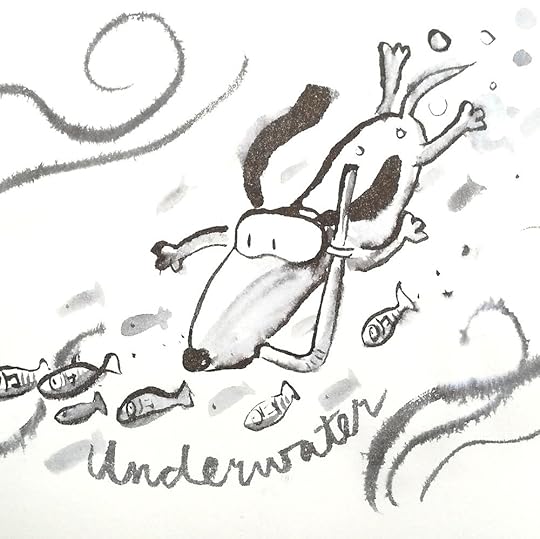
Underwater. From my Inktober 2017 project. © 2017 by Tim Warnes
What would life be if we had no courage to attempt anything?
— Vincent van Gogh
Before I even began this blog, Resistance whispered that no one would want to read it.
That there wasn’t enough time; that I'd soon run out of things to say. And of course, Who the hell do you think you are to set yourself up as an authority on kids' books?!
Unfamiliar with Resistance? It's the negative thoughts that go around your head, telling you that you’re just not good enough. It's a mythical concept created by American novelist Steven Pressfield in his non-fiction book, The War of Art, which he uses to illustrate the universal force acting against human creativity. Once we identify Resistance, Pressfield argues, there is a power shift:
Are you paralyzed with fear? That’s a good sign. Fear is good. Like self-doubt, fear is an indicator. Fear tells us what we have to do. Remember one rule of thumb: the more scared we are of a work or calling, the more sure we can be that we have to do it.
- Steven Pressfield
So when I finally launched with my first blog post, it was with a degree of trepidation - an indicator that I finally had to start this work.
Of course, none of the nay-sayings of Resistance are good enough reasons not to begin. Why shouldn’t I leverage whatever position I have to promote kid lit and reading for pleasure? Rather than regurgitate other people’s opininons, I set out to express my own - surely my experiences make them at least as valid as the next person’s? (The discipline of a weekly post is also helping me fulfil a goal of developing myself as a writer.)
Last week saw something of an upheaval in my world; this week I’m away with family - so I’ve had less time than usual in which to write. But I want to stick with the commitment I made to myself to post weekly - so today I shall share some writing from my personal journal.
The entries describe wild swimming in a mill pond at Hinton St. Mary in Dorset. (To begin with, I was a little fearful of that, too.)
The theme feels timely - last week I witnessed a friend’s baptism in the river at Wareham, after which a gang of us went canoeing and wild swimming. Yesterday was spent messing about on Coniston Water in Cumbria - with a brief landing on Peel Island, said to be the inspiration for Wild Cat Island in Arthur Ransome’s Swallows and Amazons. Peel Island was, I suppose, a story seed of sorts for Randome, who wrote that it ‘was in the distant future to play its part in some of my books, and is still, in my old age, a crystallising point for happy memories.’
As Ratty so famously puts it,
“Believe me, my young friend, there is nothing - absolutely nothing - half so much worth doing as simply messing about in boats.”
- Kenneth Grahame, The Wind in the Willows

View from kayak on Coniston Water, Cumbria. Photo © 2019 by Tim Warnes
Wild Swimming at Cut Mill8 August 2018
Plunging into the cool water, a rush of bubbles and pea green water engulfs me.
Seeing the pond from water level brings a whole new dimension, as if swimming through a nature documentary. Across the still pond, around the far edge patch of reeds, past the arrowheads and through the native yellow water lilies. I fancy that, at any moment, an otter may appear.
I swam down - not so far, maybe five or six feet. The colour of the water darkened quickly from pea soup to deep khaki. As I resurfaced, the gradation was quite something, quickly lightening to the surface, where the last few inches became a soft rainy sky grey.
Finally, some development art from I Love You As Big As the World by David van Buren (Little Tiger Press 2008).I dived down again, hoping to see some fish, again with thoughts of otters on my mind. The water became surprisingly murky though; and after the showers of the last week moved at a more obvious pace. The slippery weir was louder and its water deeper and rushing, carrying silver bubble domes rapidly across the surface of the mill pond. I could feel the pull, too, of the river as it followed its course. …
At times I thought I glimpsed the shadowy form of a fish, but it was nothing more than the effects of dust motes in my eyes. I think another time I shall bring some goggles and really see how deep I can go.
It’s based on a time when I was snorkelling off the Dorset coast - I spotted a tiny periwinkle shell and dived down to collect it for Levi.
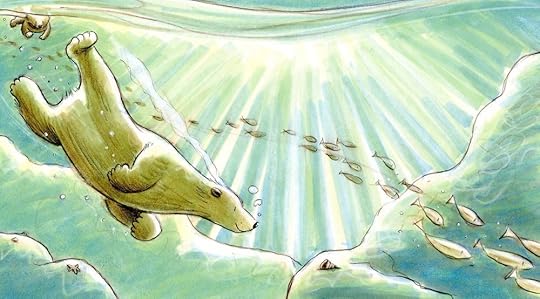
Development art for I Love You As Big As the World (Little Tiger Press). © 2008 by Tim Warnes
SourcesResistance (creativity), WikipediaThe War of Art: Break Through the Blocks & Win Your Inner Creative Battles by Steven Pressfield (Black Irish Entertainment 2012)THE WIND IN THE WILLOWS BY KENNETH GRAHAME (METHUEN 1926)
August 2, 2019
Finding Solace in a Bowl of Mush
There’s a place that I seek when I need somewhere to hide, it’s a place that I go when I need some peace of mind.
— 'The Greenway' by Emily Barker
This week, as I unpacked some beloved children's books, I received a welcome shot of solace - a feeling that reached out from the past to bless me in the present.
And strangely, it gave me some peace of mind.
The book in question? Goodnight Moon by Margaret Wise Brown, illustrated by Clement Hurd (Harper and Brothers, 1947).

© renewed 1975 by Trustees of the Edith and Clement Hurd 1982 Trust
I grew up with Goodnight Moon. I'm not sure how popular it was in the UK at the time - we had a jacketed hardback edition, sent by friends in America. Now it is a universal classic. I can remember listening to it being read in the warmth of the bedtime light, by my nan, my mum and my dad. It was as much a part of the nightly routine as the premise of the book itself - a little rabbit, saying "goodnight" to everything around him.
(Ah, that pronoun - him. The text doesn't actually refer to the rabbit as 'he'. It could just as easily be a little girl. Because who says girls can't wear blue and white stripy PJs?)
Rereading it, I realise that Goodnight Moon is an excellent example of mindfulness in action. The bunny anchors himself by observing the familiar. He sees that all is right with the world, and it calms him before bed - just as the book has done for countless millions of children. I sense this was a deliberate move on the part of Margaret Wise Brown (who studied to be a teacher). As a writer, she 'wrote books like this, and she wrote them for children, because she believed children deserve important books' (Marc Barnett, The Important Thing About Margaret Wise Brown).
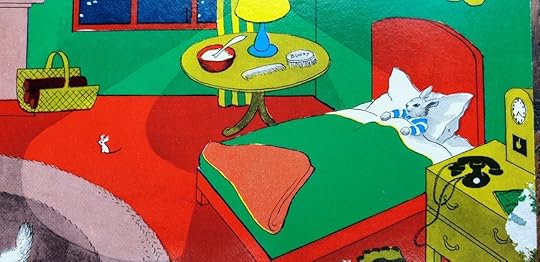
Goodnight Moon by Margaret Wise Brown, ill. by Clement Hurd © renewed 1975 by Trustees of the Edith and Clement Hurd 1982 Trust
In the great green room | There was a telephone | And a red balloon | And a picture of - | The cow jumping over the moon | And there were three little bears sitting on chairs |And two little kittens |And a pair of mittens | And a little toy house |And a young mouse
How I loved to spot that little mouse, hidden on each colour page! No matter how many times we read this, there was always one spread where the mouse was fiendishly hard to spot. (I copied this device in my Santa book, Shhh!) In my memory, the mouse lived in the toy house (influenced by my childhood fantasy of having a pet mouse, and Beatrix Potter's Two Bad Mice perhaps?). But there's nothing to confirm this. It was a construct of my imagination - an example of how a child will engage in a make-believe world.
Goodnight Moon is gently soporific, with its lilting rhyme. I imagined the quiet old lady who's whispering "hush" to be the bunny's grandmother. I likened her to my Nan Warnes, herself a calming presence, sitting and knitting.

Goodnight Moon by Margaret Wise Brown, ill. by Clement Hurd © renewed 1975 by Trustees of the Edith and Clement Hurd 1982 Trust
Read this aloud to yourself and relish its beautiful simplicity:'The sound of the words, the ideas they convey and the pictures combine to lull and reassure when bedtime and darkness come. The rhythm of the little story is like the sing-song of disconnected thoughts with which children so often put themselves to sleep, and should prove very effective in the case of a too wide-awake youngster.'
- Virginia H. Mathews, The New York Times, September 7, 1947
Goodnight room | Goodnight moon | Goodnight cow jumping over the moon | Goodnight light | And the red balloon
I have always found the effect of the colour pages getting darker and darker (in contrast with the moon and stars which appear to get brighter and brighter) deeply satisfying. I loved that as a child, especially the final spread - ‘Goodnight noises everywhere’ - where the sky and the moon look so magical. The same goes for the fire and the glow of light from inside the doll's house. (Maybe that's why I imagined the little mouse lived there - even though you can see him up on the windowsill as the little rabbit sleeps.)

Goodnight Moon by Margaret Wise Brown, ill. by Clement Hurd © renewed 1975 by Trustees of the Edith and Clement Hurd 1982 Trust
I think my only criticism of Goodnight Moon is its cover, which I find quite bizarre.
What were they thinking? I would have illustrated the little rabbit or the old lady and given prominence to the moon and stars. I would definitely have hidden that little mouse somewhere! (There’s also something else that puzzles me - what is it with the bowl of mush?!)
Goodnight Moon has become something of a Warnes family tradition. The original childhood copy is still at my parents' home. The one we have is a board book edition, a present from my parents to newborn Noah (they did the same for my nephew, Isaac). The cover blurb is spot on, describing it as a 'classic bedtime story which has lulled generations of children to sleep ... the perfect first book ...'
Unless read by Christopher Walken…
Good to ReadTried and tested soporific books to lull your kids to sleep
Goodnight Moon by Margaret Wise Brown, ill. by Clement Hurd (Harper and Brothers 1947)
Down by the River - Very Special Friends by Jane Chapman (Little Tiger Press 2012)
A Bit Lost by Chris Haughton (Walker Books)
Days Like This by Simon James (Walker Books 2000)
SourcesGoodnight Moon by Margaret Wise Brown, ill. by Clement Hurd (Harper and Brothers 1947)Lyrics to The Greenway by Emily Barker, from the album Despite the Snow by Emily Barker and the Red Clay HaloThe Important Thing About Margaret Wise Brown by Marc Barnett, ill. by Sarah Jacoby (Balzer and Bray, 2019)Classic Reviews of Beloved Children's Books - Book MarksLove Goodnight Moon? Check out my book, I Love You to the Moon and Back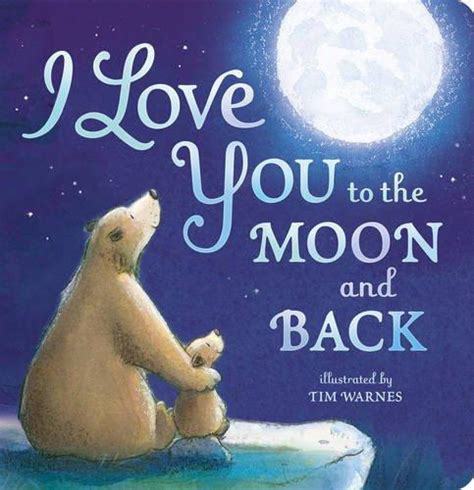
I Love You to the Moon and Back © 2015 by Tim Warnes
Average customer rating on Amazon.com: 5 starsPromoted in Book Trust’s #BathBookBed campaign
Board book edition on sale for £3.49 at
(RRP: £4.99)‘Filled with stunning illustrations … a heart-warming bedtime story.’
- The White CompanyBUY NOW!
Buy Now- USA

From I Love You to the Moon and Back © 2015 by Tim Warnes
July 26, 2019
Bonding over Richard Scarry, with my storyteller nephew

Detail from Cars and Trucks and Things That Go © 1974 Richard Scarry Corporation
At his drawing board, [Richard Scarry] could often be heard chortling at his own jokes. … He wrote because he was enjoying himself. He wanted to share the joke.
— Elizabeth Grice
Richard Scarry's books were always a firm favourite of mine.
We had several titles at home, including What Do People Do All Day?, Great Big Schoolhouse and some Tinker and Tanker adventures. When Noah was about two and a half, I fell in love with them all over again as we introduced him to the Busy World of Richard Scarry. It was like rediscovering old friends - Lowly Worm, Huckleberry Cat, Daddy Pig; the naughty Bananas Gorilla and law enforcers, Sergeant Murphy and Officer Flossie.
Scarry’s books are mostly set in the appropriately named Busy Town. Living there would be sensory overload, with crazy accidents waiting to happen and friendly emergency personnel on hand to clear up the mess!
I've written before about the importance of visual storytelling in picture books. Richard Scarry was a master at this. His illustration style is distinctive: anthropomorphic animals drawn against a white background. But not too much white background - Scarry considered too much a missed opportunity. The result? Energetic illustrations jam-packed with visual information.
Sometimes the illustrations are informative, designed to impart knowledge (as in, for example, What Do People Do All Day?). More often, his ‘illustrations tell a far more complicated story than the simple, brief text.’ They expand on the straightforward written narrative - and famously portray visual gags in the most slap-stick ways possible.
There's no denying it - you'll get your money's worth from a Richard Scarry book!
'Scarry seemed to know intuitively that, if he filled his pictures with as much detail and activity as possible, young readers would want to look at his books over and over again. And with each reading they would always find something new. … Through this device, children realized that there were all kinds of … things that the text never mentioned. … And adults learned that it was important to "read" the pictures as well as the words.'
- The Busy, Busy World of Richard Scarry by Walter Retan / Ole Risom
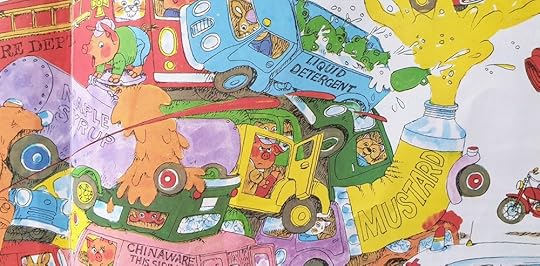
Detail from Cars and Trucks and Things That Go © 1974 Richard Scarry Corporation
Let me give you a practical example of this in action, using my seven-year-old nephew, Isaac, as an example. Isaac lives in Spain, is on the autistic spectrum - and really enjoys books. (My sister has carried on the family tradition, encouraging and sharing stories with him from birth.)
When I saw Isaac at Easter, he was really excited to show me his stories - little notebooks that he draws and writes in, creating short narratives. The theme of them all is travel, with depictions of trains, planes and automobiles, often featuring scenarios that involve bank robberies, police cars, high-speed chases - and crazy crashes! These drawings are peppered with numbers (to show, for example, speed limits, motorway junctions and boarding gates) details that give Isaac a kick.
Isaac has intuitively learned the importance of reading the pictures as well as the words - a skill (visual literacy) that he employs to tell his own stories.
My nephew is a storyteller!

Drawn by Isaac. Photo © 2019 by Tim Warnes
Isaac’s drawing above was inspired by Lego City. He explained that the car had run out of fuel but at the pumps it crashed into the bank! Now the driver’s waiting for someone to take it to the scrap yard.
Spending time with Isaac and his stories, it dawned on me that he would probably love the busy world of Richard Scarry! So for his birthday last week, I gave him Cars and Trucks and Things That Go.
'Uncle Tim,' asked Isaac, 'did you draw this book or no?'
I wish I had drawn it - because my nephew's delight was infectious and undeniable. We pointed details out to each other and laughed together as we shared Scarry's jokes. The opportunity to engage and bond with him was priceless.
'Look! An alligator car! A runaway steamroller! A car made of cheese!'

Detail from Cars and Trucks and Things That Go © 1974 by Richard Scarry Corporation
Huck Scarry's right - his father's work is still 'fresh and funny and full of things to discover.'
Isaac and I followed Officer Flossy as she chases that terrible driver, Dingo Dog, through the book. Together we searched for Goldbug - a tiny character that Scarry hid on every spread. (As I say, these books are worth every penny.)
Scarry really hit the spot. It was brilliant!

Finding Goldbug - detail from Cars and Trucks and Things That Go © 1974 by Richard Scarry Corporation
As with many autistic kids, when he's excited, Isaac expresses himself through stimming (self-stimulatory behaviour) - notably by flapping his hands.
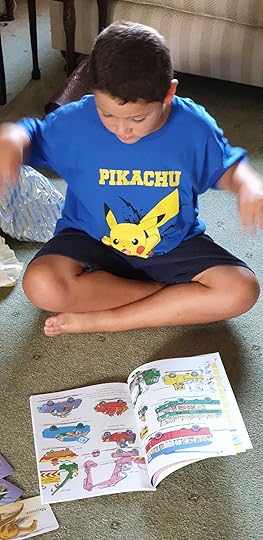
Photo © 2019 by Tim Warnes
'[S]timming can look very peculiar to people who don't understand it. Strangers can find it frightening, but in fact the explanation for it is really quite simple: stimming is doing something repetitive for the sensation it creates rather than the result it produces – and that sensation is one that your son or daughter finds pleasing.'
- Repetitive behaviours and stimming
There was a lot of flapping going on as we looked through Cars and Trucks! I wonder if Isaac’s stimming was as a reaction to his enjoyment of the book - or an add-on to enhance the pleasure he already felt?
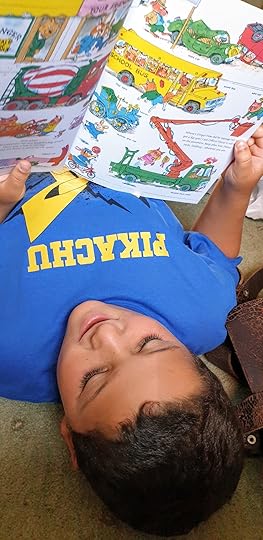
Isaac enjoying Richard Scarry’s Cars and Trucks and Things That Go. Photo © 2019 by Tim Warnes
The autistic Japanese writer, Naoki Higashida, describes the pleasure and solace he finds in picture books:
'… When I read them, my mind goes wandering off inside the world of the … book and I can freely, safely unwind. Here in the real world, there aren't many places where I and my autism can lower our guard. Like flowing water or the texture of sand or the beauty of light, my favourite picture books afford me a therapeutic comfort.'
- Picture Books; from Fall Down 7 Times Get Up 8 by Naoki Higashida
Higashida returns to picture books as an adult for therapeutic comfort. As a neurotypical individual, I can relate. And it feels good to think that maybe Isaac's introduction to Richard Scarry will provide, if not future comfort, a good laugh from time to time.
I know I will forever cherish the experience.
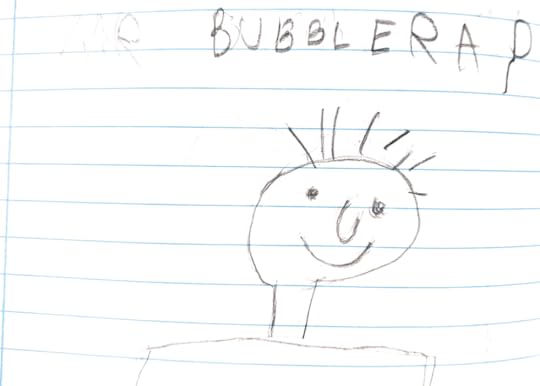
Mr. Bubblewrap © 2019 by Isaac Nash-Warnes
SourcesCars and Trucks and Things That Go by Richard Scarry (HarperCollins 1974)Busy Days on one man’s Animal Farm by Elizabeth Grice (The Daily Telegraph, 5 May 1994)The Busy, Busy World of Richard Scarry by Walter Retan / Ole Risom (Harry N. Abrams 1997)Richard Scarry - Obituary (The Daily Telegraph, 5 May 5 1994) Repetitive behaviours and stimming (ambitiousaboutautism.org.uk)An Anniversary and a Rebranding for Richard Scarry (Publisher’s Weekly, 18 June 2019)Fall Down 7 Times Get Up 8 - A Young Man’s Voice From the Silence of Autism by Naoki Higashida, translated by David Mitchell & KA Yoshida (Sceptre 2017)
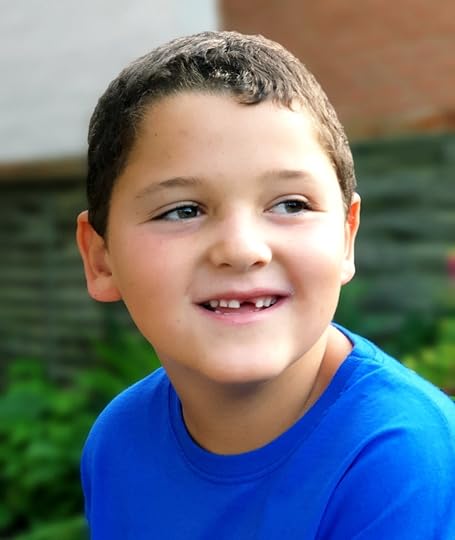
Photo © 2019 by Tim Warnes
My Life in Books
For lovers of kid lit, this memoir - My Life in Books - is intended to give you the confidence and encouragement to share your own passion; to help you make lasting connections through kids’ books.
Originally posted at www.timwarnes.com ...more
- Tim Warnes's profile
- 30 followers



